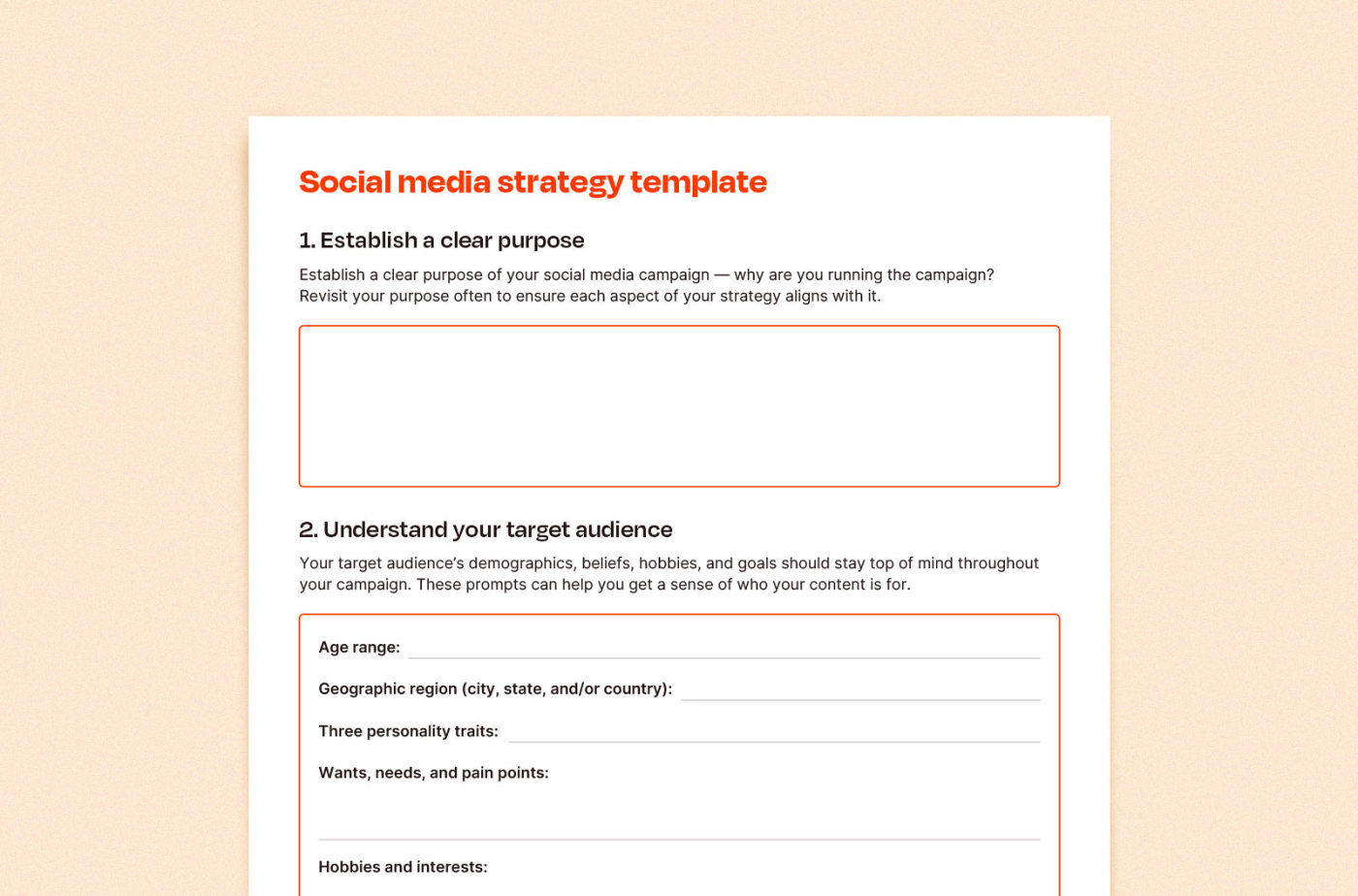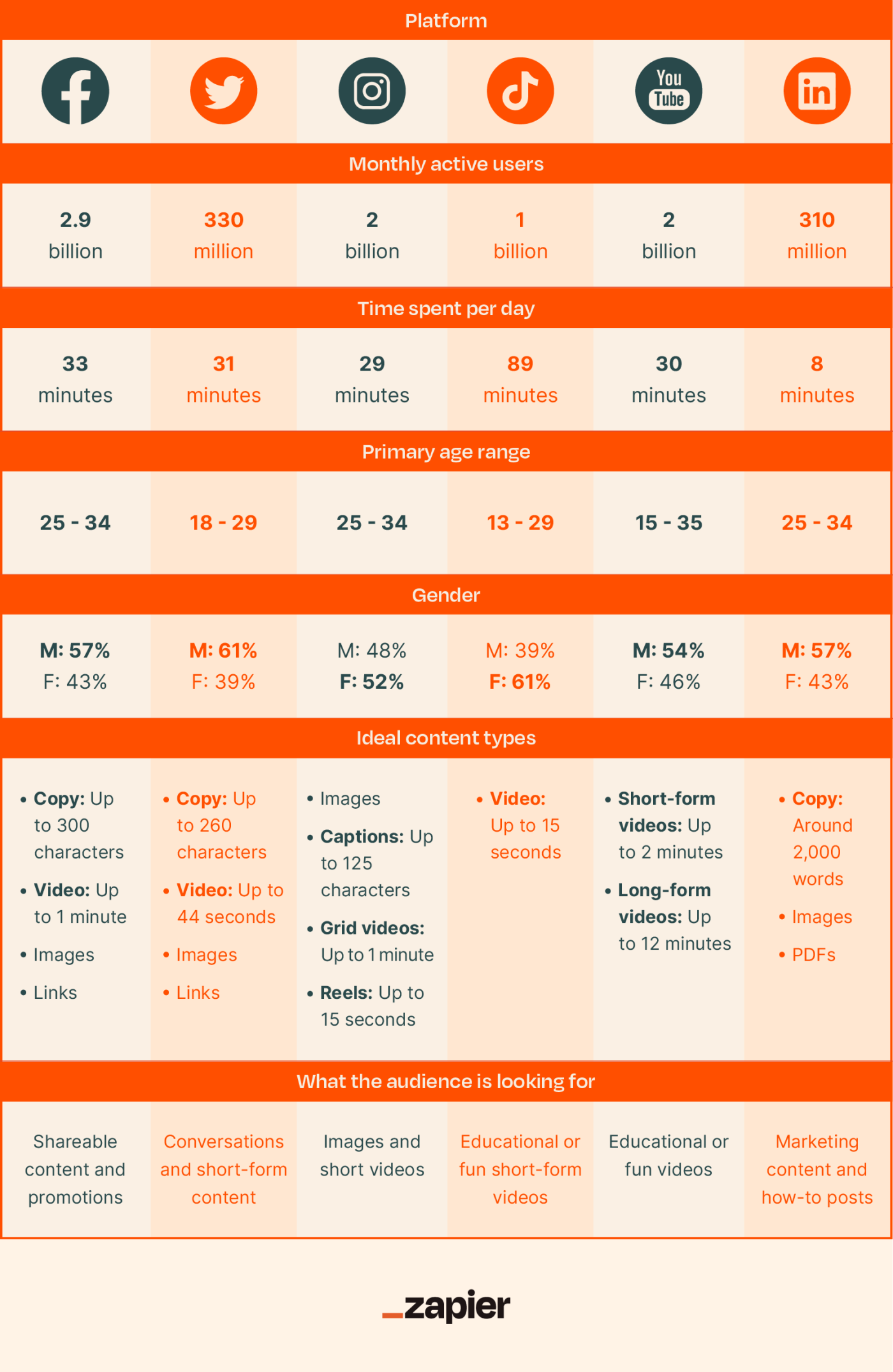I’ve been in the social media game for years now, and despite the vile cesspool of nonsense on social, there are plenty of decent people looking for what we marketers are offering. But you need to know what you’re offering.
The first step for using social media for your business is developing a successful social media marketing strategy. You’ll need this strategy before you develop a social media marketing plan (which contains the tactics needed to achieve the goals of the strategy).
To make the process easier, I developed this downloadable social media strategy template. Read on for details on how to fill it out.

How to create a social media marketing strategy
I’ve run quite a few social media campaigns for my personal brand as well as different businesses I’ve worked for. Each one had different goals, which is to be expected. But regardless of your end goal, you can use the same big ideas to formulate your social media marketing strategy.
1. Establish a clear purpose
4 workflows to better market your brand on social media
I can’t tell you how many social media managers I’ve seen just throw as many things at the wall as possible and hope something sticks: giveaways that get short-term engagement, services that guarantee followers and likes, or jumping on whatever the most recent bandwagon is. What these lack is a clear purpose.
Your purpose outlines how social media marketing will help your brand. Write out a statement that starts with “The purpose of social media marketing at [Brand name] is to…” and includes aspects like:
When you have an overarching purpose, the rest of the strategy planning is a cakewalk. It also makes it easy to adjust your social media strategy as you go without losing sight of your long-term goals. Each time you make a social media decision, ask yourself: does this align with the purpose? Yes? Keep it. If not, get rid of it.
2. Understand your target audience
Before sitting down to map out your social media strategy, figure out who you want to see your content (and whether they want to see it). If your company already has a good understanding of your target consumer, boom—you’re off to a great start. Use that research for your social media strategy. If you don’t have a target audience already, curate an audience persona to flesh out their “character.” For true crime fans, think of it like being a profiler.
From there, orient each part of your strategy—from which platform you post on and when to what metrics you’re trying to hit—toward that target audience.
Aim to create a strategy that answers all of these questions:
-
Is your strategy respectful of your audience’s backgrounds and experiences, and what value does it add to their lives?
-
What are you hoping they take away from your content, and what are they hoping to take away from it?
-
What existing knowledge do you expect them to come with, and what can you teach them?
3. Research your competitors
As much as we all want to feel like unique, creative geniuses, everything is inspired by something. But don’t just copy what your competitors are doing—ask yourself why they’re doing it that way and what the thought process is behind it.
Here are some questions you can consider when filling out the social media strategy template:
-
Who are your competitors trying to target?
-
Why is their strategy working?
-
What social media platforms are they using and why?
-
What social media platforms aren’t they using and why?
-
How often do they post content to each platform?
-
Are they replying to comments?
-
What is the ratio of posts trying to sell something compared to fun, interesting, or educational content?
Look for gaps and opportunities that your competitors—whether they’re crushing it on social or not—aren’t taking advantage of. What are they missing that you think your target customers would enjoy?
Let’s say you’re a vegan restaurant and other vegan joints only post images of their food. They may have plenty of followers, likes, and sales, but you know you can do more. You can post behind-the-scenes videos, recipe tutorials, and images of your clientele with rich anecdotes as captions, Humans of New York style, to show your audience you’re more than a menu.
Or maybe it’s even simpler. Let’s say a competitor isn’t getting a ton of engagement on their posts, and you notice they never end their captions with a discussion question. Try including this simple call to action in your own captions to encourage more comments and drive up your engagement.
4. Choose the right social media channels
Just as there’s a “right” audience for your content, there’s a right channel (well, channels) for it as well. We don’t have to spell out what each platform does, but knowing some ins and outs of them will be key when using social media for your business.

Make sure the social platforms you choose are right for your brand. Consider some of the following questions:
-
Does the platform host your target audience?
-
Is it working for your competition?
-
If it’s not working for the competition, is it because your target audience isn’t there or because competitors are doing something wrong?
-
Does it fit well with the content you plan on making?
-
Is it worth your time and effort to create content for it?
Once you’ve chosen the social media platforms you plan to use, check out these channel-specific guides for more detailed strategy tips:
5. Determine your KPIs
So, what exactly does social media “success” look like? Bringing in more business, sure, but that’s a little vague. You want to see that your social media strategy is hitting smaller goals along the way. To gauge how your strategy is paying off, define some quantifiable key performance indicators, or KPIs.
Here are some examples:
Impressions:
-
What is it? How many people saw your posts
-
Example KPI: Reach at least 1,000 unique users for every post
Likes:
Shares:
Comments:
Engagement:
-
What is it? A combination of likes, shares, follows, and anything where a person engaged with a post or your account
-
Example KPI: 10% more overall engagement than prior campaign
Click-through rate:
View duration:
-
What is it? How much of your video people watched (though each platform varies in how this is measured)
-
Example KPI: Average view duration of 20% per video
Conversions:
With easy-to-use reporting tools, you can track your progression toward KPIs.
You need to please the social media algorithms in order to get your content promoted organically, and the algorithms care about engagement. Social media engagement, like shares, comments, and likes directly impact every other KPI due to how the algorithms work, so engagement should be your main focus.
6. Conduct a social media audit
As marketers, analytics are our bread and butter (if you’re wondering why you’re salivating right about now). A social media audit highlights the data behind your efforts.
It’s probably a good idea to audit your accounts before embarking on a campaign to get a sense of where you’re starting off. But most importantly, perform an audit after each campaign to ensure your strategy is paying off.
Other than your KPIs, here are some things to track when you audit yourself:
-
What types of content you’re posting and on which platforms
-
How much engagement each post received
-
How many followers you have (or gained/lost)
-
Any positive or negative comments
-
Whether you’re reaching your target audience or not
For some of these, a human’s perspective makes sense. For the more granular work, a social media management tool can help make the auditing process a whole lot easier.
How to get the most out of our social media strategy template
This template for your social media strategy will help you document everything we just covered. If your goals and KPIs change when you start a new campaign or marketing plan, you can reuse this template to outline your new strategy.
And as you execute your strategy, it never hurts to automate as much as possible, so you can focus on content creation. Here are some tips for getting started with social media automation:
This article was originally published in November 2020 by Tierney Mosier. The most recent update was in August 2022.
[adsanity_group align=’alignnone’ num_ads=1 num_columns=1 group_ids=’15192′]
Need Any Technology Assistance? Call Pursho @ 0731-6725516







